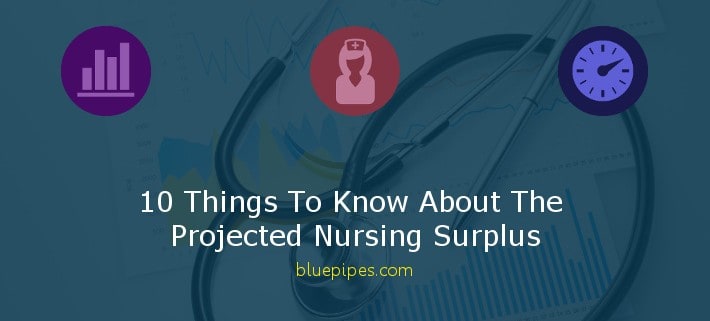10 Things To Know About The Projected Nursing Surplus
In 2004, the federal government’s Health Resources and Services Administration (HRSA) projected a nursing shortage of 808,000 Registered Nurses by the year 2020. Healthcare staffing companies, education institutions and other interested parties tout these numbers as proof that their services should be in great demand.
However, in December of 2014, the HRSA projected a surplus of 340,000 Registered Nurses by 2025. In July of 2017, the HRSA projected a surplus of Registered Nurses by 2030.
Of course, a shift from shortage to surplus would have major implications on the RN employment market. We’ll take a look at 10 things nurses ought to know about the reports projecting a shift from nursing shortage to nursing surplus.
In this article, we focus on the HRSA’s report from 2014. The HRSA report from 2017 is largely similar. Therefore, the issues and discussion are by and large the same.
1: Why the Nursing Shortage Was Projected
The projected nursing shortage was well publicized so the reasons are commonly known. However, there are some reasons that are less known than others. Knowing the reasons for the projected shortage helps us critically analyze the projected surplus and the issue in general. So here is a list of reasons that HRSA provided for the projected shortage:
- An aging population will result in increased demand for healthcare services.
- A significant percentage of the nursing workforce was projected to retire over the coming years.
- A significant percentage of Registered Nurses leave the profession or opt to work less than full time hours.
- The number of newly graduating RNs was too low to keep pace with increasing demand.
- There weren’t enough nursing educators for schools to keep up with demand.
- Increasing employment opportunities for women was leading many to choose different career paths and men were not adopting the profession.
- The nursing profession was experiencing stagnant pay.
- Working conditions for nurses were becoming more onerous.
- There was a decline in the public perception of nursing as a career choice.
With this information in mind, let’s take a look at the HRSA’s most recent report which projected a surplus of 340,000 RNs by 2025.
2: There Are More Nursing Graduates Than Originally Anticipated
According to HRSA, 68,000 new graduate RNs entered the workforce in 2001. At the time, HRSA predicted that there would be little to no growth in the annual number of new graduates. In fact, they estimated that the number of new graduates would barely cover the annual number of retiring nurses. They recommended that the number of new grads be increased to 130,000 per year to keep pace with demand.
In the new report, the HRSA found that there were over 150,000 new grad RNs in 2012 and 2013. That’s an increase of more than 100% from 2001 levels. It’s also more than the HRSA had originally recommended.
3: The HRSA Doesn’t Account For Nursing Degree Level
One of the criticisms levied against the HRSA’s report is that it doesn’t consider the education level of new graduates. The report also doesn’t consider the demand by education level. Critics claim that this makes it impossible to know whether or not the nursing workforce will be qualified to meet the demands of the employment market.
While the data wasn’t included in this particular report, the HRSA has data available in other reports. In 2013, the HRSA reported that only 55% of the current RN workforce had a Bachelor’s degree and that 43% of first-time NCLEX test-takers held a Bachelor’s Degree.
Meanwhile, demand for Bachelor educated nurses is on the rise. Achieving Magnet Status from the ANCC requires that all nursing managers hold a Bachelor’s Degree. The Institute of Medicine has called for 80% of all nurses to hold a Bachelor’s Degree by 2020. And the Bureau of Labor Statistics forecasts that demand for Advanced Practice Registered Nurses will increase by 31% through 2022.
4: HRSA Nursing Growth Estimates Are Debated
To forecast the number of nurses that would be trained by 2025, the HRSA had to estimate a growth rate. In doing so, they assumed that RNs would continue to train at current levels. In other words, we will continue to see over 150,000 new graduates per year. As a result, they estimated that the supply of Full Time Equivalents would increase 33% by 2025.
However, Dr. Peter Buerhaus of Vanderbilt University and his colleagues recently found that the growth rate would be in the neighborhood of 20-25%. That’s a 10% difference from what HRSA predicted. This difference would result in approximately 290,000 fewer nurses. Remember, the HRSA is forecasting a surplus of 340,000, so this difference would bring it down to a surplus of 50,000.
BluePipes: Professional Networking and Career Management Tools for Healthcare Professionals
5: Major Regional Variations in Nursing Supply and Demand are Projected
We’ve discussed regional variations in the supply and demand of registered nurses in a previous blog post and the HRSA forecast illustrates just how profound these variations are. The HRSA breaks the country down into four regions, the Northeast, Midwest, South, and West.
Nine states make up the Northeast. Of them, only Rhode Island and Maine are projected to have shortages with deficits of 2,100 and 1,700 respectively. New York, New Jersey and Pennsylvania are all projected to have surpluses of greater than 20,000.
Twelve states make up the Midwest and not one of them is projected to have a shortage. Ohio is projected to have a surplus of 75,400 which is by far the largest surplus of any state. In fact, the next closest state on the list, Pennsylvania, has a projected surplus of 25,800. That’s a difference of over 200%!
There are 16 states in the South. Of them, only Georgia (6,700), Maryland (12,100), North Carolina (12,900) and South Carolina (600) have projected shortages.
Thirteen states make up the West where the tables are turned. Of them, only Idaho, Utah and Wyoming have a projected surplus with 700, 5,800, and 1,900 respectively. Every other state is projected to have a shortage with Arizona topping the list at 28,100.
6: State Nursing Projection Limitations
The HRSA points out that there is a limitation to its state-level projections. Specifically, they assume absolutely no migration. In other words, they assume that nurses will stay in the state in which they earn their degree. Of course, if their projections are correct, then migration won’t solve the problem, it will just even the playing field a little.
7: The HRSA Assumes That Current Demand Equals Current Supply
It’s important to remember that the original shortage projections were made well before the Affordable Care Act (ACA) was even a possibility. Recently, The Rand Corporation published a study indicating that an additional 17 million Americans now have health coverage as result of the ACA.
Meanwhile, the HRSA’s newest report makes the assumption that the current supply is equal to the current demand for RNs. The report goes on to cite this assumption as a limitation. According to the report, this is a standard practice in forecasting healthcare labor statistics. Either way, it’s fair to say that the resulting projections are only really relative to the current market.
8: The HRSA Nursing Forecast Includes Alternative Scenarios
It’s important to note that the HRSA report includes some alternative scenarios. First, the report indicates that if demand for RNs returns to the pre-recession highs that were exhibited prior to 2007, then the projected surplus would decline from 340,000 to 236,000. Some might argue that this is a likely scenario given the recent surge in demand for RNs in 2015.
Additionally, if the number of graduates per year were to be adjusted from 150,000 to 130,000, then the projected supply and demand for Registered Nurse would be in alignment. Given the surge in nursing school enrollment that ensued after news of the projected nursing shortage became widespread, it is possible that enrollment rates drop once people hear that there is a projected surplus. Of course, this scenario relies on news of a nursing surplus becoming widespread.
Finally, the report offers a scenario that could potentially result in a nursing shortage by 2025. It explains that nursing graduation rates have been cyclical since the 1980s. The cycle is characterized by sharp increases in graduation rates followed by declines of up to 25%. If this cycle repeats and is coupled with nurses retiring an average of 2 years earlier than pre-recession levels, then there would be a nursing shortage of 86,00 RNs in 2025.
9: The Study Does Not Account For Emerging Care Delivery Models
The HRSA study also cites a limitation that could potentially throw its numbers off significantly. Specifically, they point out that a shift toward new care delivery models which focus on managing health status and preventing acute health issues are likely to result in expanded roles for nurses and therefore increased demand. That said, there are others who would argue that advancements in technology and patient care could reduce the role of nurses and thereby reduce demand for nurses.
10: The Study Doesn’t Consider Specific Specialties
Finally, the HRSA study doesn’t look at individual nursing specialty areas. This is important because there is some evidence that certain specialty areas are experiencing shortages while others are experiencing surpluses. Of course, healthcare employers would simply need to provide the training necessary to get adequately educated candidates up to speed in order to overcome this problem.
There is a lot of room for debate over the newly projected nursing surplus. One thing is for sure. The annual number of new grad RNs has increased significantly since 2001. It’s fair to say that a lot is riding on whether or not this trend continues. Either way, it will be interesting to see how this issue plays out in the years to come.
As always, we’d love to hear about your thoughts or experiences with this issue and answer any questions you may have. Please post them in the comments section below!




Hi. I love using blue pipes for all my travel nurse questions. It has been so helpful in my travel career that I just began a week ago. Is there a place that denotes when the article was written or published? Month, day, year? It would help to know the date when researching questions; in order to know how relevant the answers are to the status quo.
Hey Melissa,
Thanks for the inquiry. My apologies, but we don’t post dates on our articles. We consider the vast majority of the articles we publish to be “evergreen”, meaning that they are not current events and tend to remain unchanged for very long periods of time. When we do write articles that are based on current events, the date can be seen throughout the article. For example, this article cites the dates of the various sources. If something changes with respect to topics in our “evergreen” articles, then we update the article to reflect the change.
We do this for technical reasons related to Google SEO and WordPress, the content management system we use to manage the Blog. My apologies for any inconvenience.
What this does not take into consideration is the rate of burnout in hospitals among nurses. Yes the schools may be pumping out nurses at a surplus rate but this does not mean these new grads are staying in the field. The average time to reach “burn out ” is 5 years at the bedside and these nurses are going to other non patient care areas. So if you go by shear numbers, yes there is a surplus, but if you really look at the trends in the profession we will still be short at the bedside. Since federal funding to hospitals has been cut, hospitals have had to cut their budgets, along with cuts to staffing which contributes to the high burn out rate. Sometimes it isn’t all about the numbers.
Why were Associate Degree RN programs allowed to enroll students from 2007 on if the colleges knew that the BSN was going to be a requirement for new grad RN’s to get a hospital job? We ( 2009 RN grads) all did our clinicals in hospitals, but after graduating we couldn’t even work in a hospital ( unless you had an inside connection from before).
Wow, what a great analysis! There are so many other cause/effect variables to consider (i.e. many, if not all, Boards of Nursing in each state have oversight on nursing school enrollment levels) that this remains a controversial and debatable topic. I’m curious to know if we’ve experienced a level equivalent to the estimated nurse surplus vs estimated patient population for 2025. Was that part of the report, or has this ever even occurred before?
Thanks, Mike! I didn’t even consider the Board of Nursing issue; that’s a great point. The report didn’t mention anything about these levels ever occurring before. I’m curious though, and will look around to see if I can find some data. I hope all is well!